Royal Society - David Keith
Royal Society - David Keith
Royal Society - David Keith
Create successful ePaper yourself
Turn your PDF publications into a flip-book with our unique Google optimized e-Paper software.
It might be argued that one easy way to implement P<br />
fertilisation of the oceans is to allow and even encourage<br />
agricultural fertiliser runoff, which eventually reaches rivers<br />
and the oceans. Such runoff is however one of the<br />
principal causes of the substantial damage to freshwater,<br />
estuary and coastal ecosystems by eutrophication that has<br />
already occurred over recent decades. Increasing still<br />
further this pathway for addition of P to the oceans is not<br />
an option that society is likely to find acceptable.<br />
2.3.2 Oceanic upwelling or downwelling<br />
modification methods<br />
A second group of ocean-based methods is based on the<br />
principle that the rate at which atmospheric carbon is<br />
transferred to the deep sea may be enhanced by increasing<br />
the supply of nutrients by the upwelling or overturning<br />
circulation of the ocean (Submission: Duke). It has been<br />
proposed both to enhance upwelling rates locally using<br />
vertical pipes to pump water from several hundred metres<br />
depth to the surface (eg, Lovelock & Rapley 2007;<br />
Submission: Atmocean Inc.) and to promote downwelling<br />
of dense water in the subpolar oceans (Zhou & Flynn<br />
2005). Most of the CO 2 in the deep sea is transported there<br />
by the overturning circulation (the ‘solubility pump’) and<br />
not by biologically-driven sedimentation (Sarmiento &<br />
Gruber 2006), so there is some expectation that increasing<br />
this circulation will lead to more rapid sequestration.<br />
However, once again the calculation of the efficiency<br />
of sequestration must take account of non-local effects:<br />
increasing ocean downwelling (or upwelling) must be<br />
compensated by increased upwelling (or downwelling)<br />
at another location, which may in general be on the<br />
other side of the world and which also will affect the<br />
carbon balance.<br />
Zhou and Flynn estimate that increasing downwelling<br />
water by 1 million m 3 /s, which would be a very substantial<br />
engineering challenge, would increase ocean uptake<br />
of carbon by only ~0.01 GtC/yr. The amount of carbon<br />
sequestered by the ocean pipes proposal will depend<br />
critically on location and may well be negative, for example<br />
leading to release, rather than uptake, of carbon from the<br />
ocean (Yool et al. 2009). Making optimistic assumptions,<br />
it is estimated that enhancing upwelling by 1 million m 3 /s<br />
would lead to sequestration of only ~0.02 GtC/yr (Lenton &<br />
Vaughan 2009).<br />
2.4 Discussion<br />
On the basis of the available literature, indications are<br />
provided in Table 2.9 of maximum effects of the respective<br />
technologies on CO 2 concentrations in the next century.<br />
Figures are informed by the literature cited, and by Lenton<br />
& Vaughan’s (2009) strong mitigation scenario table II, in<br />
which atmospheric CO 2 concentrations rise to 450 ppm in<br />
2050 and stabilise at 500 ppm in 2100. Deliberately wide<br />
ranges are given, intended only to show the approximate<br />
potential of these technologies if deployed to the<br />
maximum, regardless of cost or possible side effects.<br />
Costs are assessed as ‘low’ if generally less than $20 per<br />
tonne of carbon sequestered, medium if between $20<br />
and $80, otherwise ‘high’. Risk is assessed as high for<br />
those technologies that involve manipulating the ocean<br />
or relatively undisturbed natural land ecosystems at a<br />
large scale, and medium for agricultural and biomass<br />
technologies, on the rationale that agricultural impacts<br />
are relatively well understood and would not directly<br />
affect undisturbed terrestrial ecosystems.<br />
It is clearly technically possible to remove CO 2 from the<br />
atmosphere using many different technologies, ranging<br />
from ecosystem manipulation to ‘hard’ engineering. Plans<br />
to begin removal using some methodologies are in place<br />
now, and if societies put a realistic value on carbon<br />
removed (for example, more than $30 per tonne of carbon),<br />
it would start to happen with existing technologies.<br />
All other points being equal, methods that are (not in any<br />
order of preference): (1) cheaper, (2) have fewer possibly<br />
unintended side effects, (3) have large potential to remove<br />
CO 2 , and (4) do not involve manipulation or interference<br />
with natural or near-natural ecosystems are likely to be<br />
preferred. Methods which: (5) are likely to be easily<br />
accepted by society and (6) do not raise difficult issues<br />
of governance are also likely to be favoured. Since none<br />
of the proposed methods meets all of these criteria it is<br />
necessary to balance these different properties against<br />
one another, and this is bound to raise differences<br />
of opinion.<br />
The ocean fertilisation proposals are virtually the only ones<br />
that have had anything amounting to sustained research<br />
activity by the scientific community. This is an historical<br />
accident, because relevant experiments were undertaken<br />
to address fundamental research questions in marine<br />
science, and not because of their possible geoengineering<br />
applications. In the geoengineering context, the sole<br />
attraction of these methodologies is that iron (and<br />
possibly phosphate) fertilisation are potentially relatively<br />
inexpensive. They do however have only a relatively small<br />
capacity to sequester carbon, and verification of their<br />
carbon sequestration benefit is difficult. Furthermore,<br />
there are likely to be unintended and probably deleterious<br />
ecological consequences. With these drawbacks societal<br />
and political acceptance is likely to be low. Ocean<br />
circulation methodologies have the same issues, but<br />
also appear to have effects on atmospheric CO 2 that<br />
are too small to be worthwhile.<br />
Methods such as BECS, biomass burial and biochar, which<br />
use biomass to sequester carbon, appear to have relatively<br />
low cost, with moderate and predictable environmental<br />
impacts and low-to-medium risk of unanticipated effects.<br />
However, unless deployed on a very large scale, the carbon<br />
sequestration potential is moderate, and there would be<br />
competition with biofuels and agriculture for use of<br />
available land. However the carbon sequestered by<br />
biomass burial and biochar has value as fuel, and it could<br />
be preferable to use this and displace fossil fuels such as<br />
coal, at least until abundant low-carbon energy becomes<br />
available. Land use management (afforestation and<br />
The <strong>Royal</strong> <strong>Society</strong><br />
Geoengineering the Climate I September 2009 I 19








